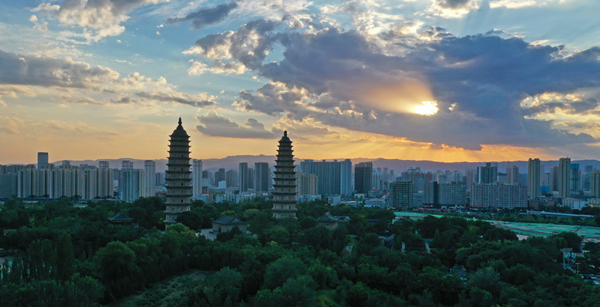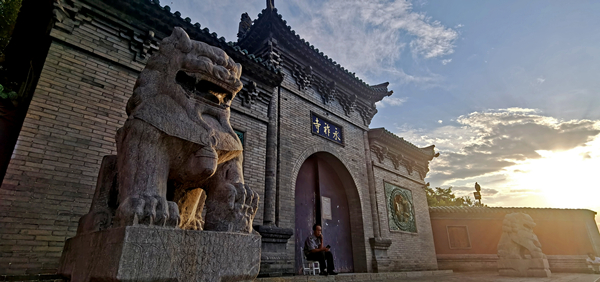
The double pagodas in Yongzuo Temple have stood as landmarks of Taiyuan for nearly 400 years. [Photo by Li Yongjiang for China Daily]
Historic landmark exhibits innovative and unique features of Ming Dynasty architecture
The double pagodas at Yongzuo Buddhist Temple have been standing as landmarks of Taiyuan, the provincial capital of Shanxi, for some four centuries and remain a major attraction in the city today.
The double pagodas are so famous that locals in Taiyuan usually refer to the temple as Double Pagodas Temple, and will even hesitate when asked where Yongzuo Temple is.
The tallest preserved pagodas in the nation, the beamless hall built in the Ming Dynasty (1368-1644), the stone tablets with inscriptions of renowned calligraphic works from past centuries, and the peonies planted in the Ming Dynasty are the four major selling points of the temple, according to a local official in charge of tourism.
Lu Ling, the temple's official, said the two pagodas were built in the late Ming Dynasty and early Qing Dynasty (1644-1911).
The official said the temple was divided into upper and lower gardens. The upper garden is called the Pagoda Garden because it is where the double pagodas are located.
The pagoda in the south is called the Peak of Culture Pagoda, which was built under the sponsorship of Fu Lin, a local scholar and official during the Ming Dynasty.
It is said the construction of the Peak of Culture Pagoda was aimed to lifting Taiyuan's status as a cultural city and improving the "cultural fortune" of the sponsor's family.
Coincidentally, several decades after the construction, Fu's grandson Fu Shan became one of the country's top scholars, poets, calligraphers and painters of his time.
The story has made the temple a favorite among local intellectuals and residents who wish for good academic fortune for their children.
After weathering winds and rains for four centuries, the Peak of Culture Pagoda became a leaning tower with a gradient of 2.86 meters in the last century, according to Lu.
"A team led by ancient architecture master Cao Shizhong repaired the tower in 1995, which rectified the gradient to 0.86 m," Lu said.
The pagoda in the northwest is called Xuanwen Pagoda, and was built by famed Buddhist monk Miaofeng several years after the completion of the Peak of Culture Pagoda.

Home to a number of ancient structures, Yongzuo Temple is a major attraction in Taiyuan. [Photo by Li Yongjiang for China Daily]
In addition to the pagoda, the majority of the structures in Yongzuo Temple were built under the supervision of Miaofeng.
Miaofeng died before the entire project was completed. Xuanwen Pagoda and other structures were completed in the early Qing Dynasty.
"Xuanwen is slightly higher than the Peak of Culture," Lu said, adding that this pagoda has a great significance among Buddhists.
The pagoda is also called the Sarira Pagoda as it houses the sarira of Sakyamuni. Sarira are the bone relics after the cremation of Buddha or saintly monks, Lu explained.
"Xuanwen was partly destroyed during a war in the 1940s and it was restored in 1984," Lu said.
The lower garden is home to the majority of ancient structures. And among the structures, the beamless hall is the most prominent, according to the official.
"Relics of earlier beamless halls were mostly discovered in the underground parts of ancient mausoleums and tombs.
"Such structures began to emerge on the ground in the Ming Dynasty with the development of architecture techniques," Lu said.
The beamless hall in Yongzuo was designed by Miaofeng.
"All the structures to support the entire hall were made of bricks. However, the brick columns and dougong brackets were all made in the shape of wooden structures, showing the high level of techniques and aesthetic taste of the times," Lu said.
In addition to the brick structure, she said the colored statues of bodhisattvas in the hall are also worth close study as they are representative of Ming Dynasty sculpture.
The temple is also famous for its centuries-old peonies.
The most renowned variety of peony at the Double Pagodas Temple is called the "purple cloud fairy", which is said to have a history of more than 300 years.
Purple cloud fairy peony flowers are mostly located in front of the main hall of the temple.
The temple has more than 30 other varieties of flowers. The number of peony trees there totals 6,000.
The temple's collection of more than 260 stone tablets with inscriptions of renowned calligraphic works from the past millennium is a must-see attraction for calligraphy enthusiasts, according to Lu.
Li Yali contributed to this story.
